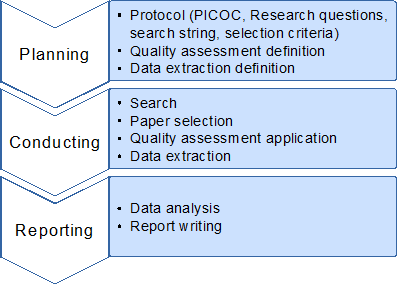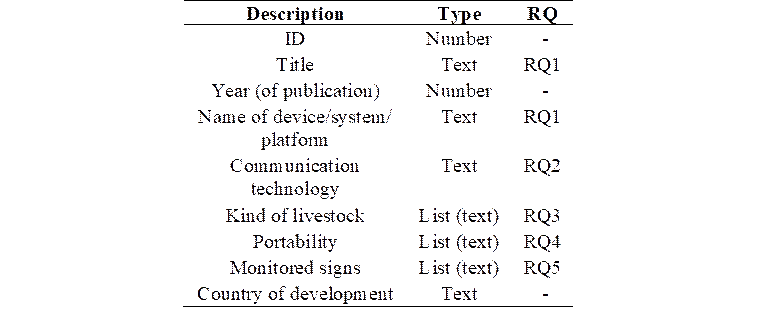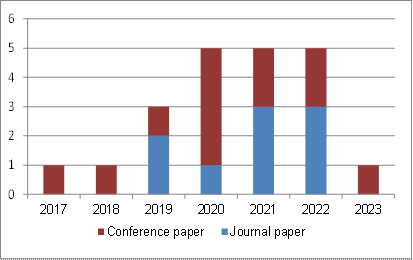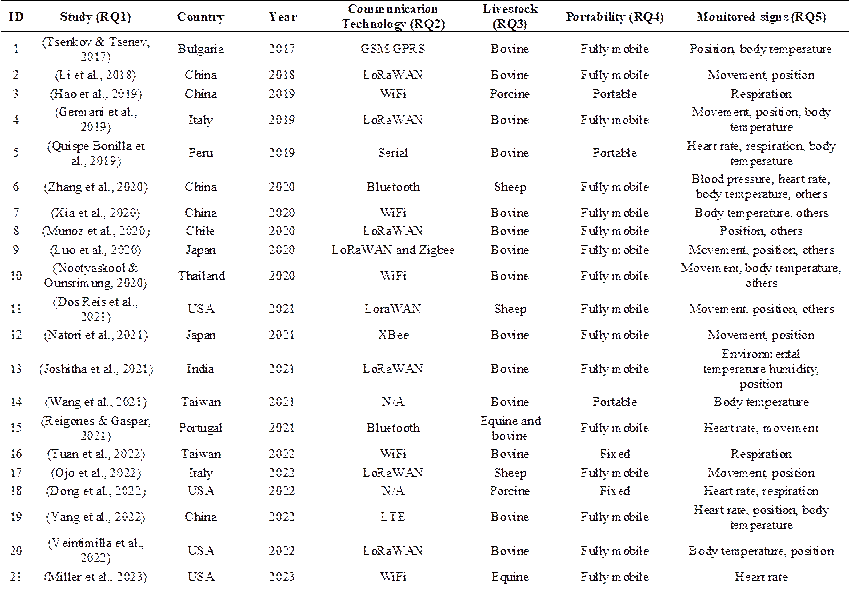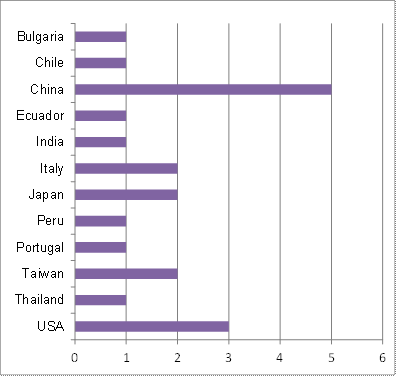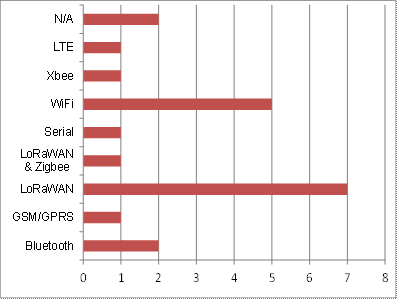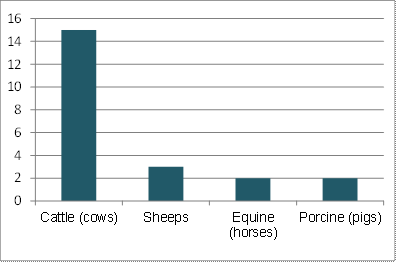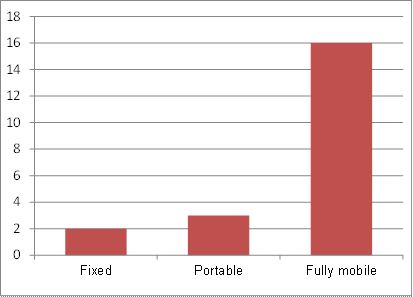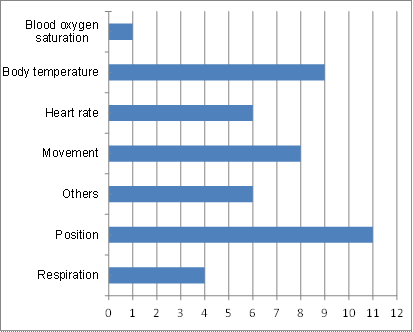1. INTRODUCTION
Livestock is one of the main economic activities in rural areas, whether in developed or developing countries. However, while the use of technology in this field is expected in the former, in the latter it is rare.
Livestock health is an important issue that affects farmers' productivity and finances. Livestock diseases not only affect the productive capacity of the animal but also imply additional expenses for treatment of the disease (Ibarra et al., 2023). On the other hand, improving livestock welfare can improve both their health and the quality of the products obtained from them (Orihuela, 2021).
In countries where the use of technologies for livestock is not usual, problems arise that require solutions. For example, in Ecuador, in 2020, there were more than 200,000 deaths from different causes (not slaughtered for consumption) and 91,889 abortions out of an approximate total of 4,486,020 existing cattle animals (INEC, 2020). Many of these deaths can be attributable to animal health problems, as indicated by other researchers (García-Márquez et al., 2023; Macías-Rioseco et al., 2020).
Applying ICT in this sector could help livestock producers solve problems like this. In Latin America, the potential of the application of ICT in the productive sector has already been analyzed previously (Vergara Villegas et al., 2021). In contrast, there are extensive proposals for platforms oriented to the rural sector, such as the one presented in Nigussie et al. (2020).
One way to contribute to the control of the health of livestock, and therefore to the productivity of the rural sector and the economy of farmers, is the proper monitoring of vital signs and behavior of animals. Although there are some commercial products in this sense, such as Icerobotics (n.d.), Allflex Livestock Intelligence (2024), Ixorigue n.d.) or Zoetis (2021), it is possible that they do not cover all the necessary parameters for adequate health control. Likewise, there are systems or devices proposed in the scientific literature that allow monitoring one or more constants or vital signs, focused on different types of livestock.
This paper presents a systematic literature review (SLR) on systems, applications or devices to monitor vital signs in livestock. The objective of this work is, however, to illustrate the state-of-the-art of this subject in recent years and, on the other hand, to analyze the trends and pending challenges in the subject, with a focus on livestock health. The rest of the article is organized as follows: Section 2 presents how the SRL was carried out. The following section shows and analyzes the results obtained, and in the last section, the conclusions of this work are presented.
2. RESEARCH METHODOLOGY
The methodology applied in this study is based in PRISMA (Preferred Reporting Items for Systematic Reviews and Meta-Analyses). To help us in the process, the online tool Parsifal (https://parsif.al) was used.
The review process had three main phases: Planning, Conducting, and Reporting (outlined in Figure 1), which are described below.
2.1 Planning the Review
Here, we prepared the protocol to follow along with the review. First, we determined the search PICOC (Population, Intervention, Comparison, Outcome, Context) keywords. These terms are shown next:
Population: livestock, cattle, agriculture.
Intervention: vital signs.
Comparison: monitor, monitoring, platform, device.
We have used lists of keywords instead of synonyms. With the keywords listed, a base search string was elaborated, which is shown next: ("livestock" OR "cattle" OR “agriculture”) AND ("vital signs") AND ("device" OR "monitor" OR "monitoring" OR "platform")
We defined five research questions (RQ), listed next:
RQ1. What systems or devices exist for monitoring the vital signs of livestock?
RQ2. What communication technologies are used by systems or devices for monitoring livestock vital signs?
RQ3. What kind of livestock are these systems or devices focused on?
RQ4. Are these systems or devices portable, mobile or fixed?
RQ5. What signs do these systems or devices monitor?
The inclusion and exclusion criteria are described now. The inclusion criteria seek to retrieve papers from journals and conferences (proceedings), published from 2017 to July 2023, in English or Spanish languages. These last must have at least an abstract written in English.
Exclusion criteria are listed below and they are focused on discard incomplete, non-accessible, or non-novel publications, as well as which are about topics different than the planned:
Abstracts, Books chapters, Early access, Editorials.
Reviews
Duplicated
Non-accesible content
Other language than english or Spanish
Other topics
We defined three Quality Assessment Questions (QAQ) to determine the suitability of selected papers. These questions, listed below, helped us to find papers with relevant data in its content:
QAQ1. Has the proposal been tested using real devices?
QAQ2. Has the system been tested in real livestock?
QAQ3. Does the document sufficiently describe the technical information about the implementation?
A paper is considered for the SLR if it gets at least 1.5 points in this assessment. The possible answers and weight of each QAQs were:
2.2 Conducting the review
For the review, five scientific databases were selected for the search: ACM Digital Library, IEEE Xplore, Science Direct, Scopus, and SpringerLink. Besides the base search string defined before, in each database it was necessary to adjust some search parameters (e.g. year range or type of publication).
After the search in each database was performed, a first selection of papers was determined according to selection criteria shown before. Next, the QAQs were applied to the selected papers. After that, data extraction was performed from the papers which obtained at least 1.5 points in quality assessment. Data fields for extraction are listed in Table 1.
2.3 Reporting the review
With the data extracted from the last selection, some analysis was performed. These analyses cover both technologies for communication and signs monitored in livestock, and they are shown in the next section.
In addition to papers found in the search, we made a brief analysis of commercial products available and promoted in Internet. After that we wrote this paper.
3. RESULTS
Paper selection and extraction
The results of database search are shown in Table 2. A total of 892 papers where found. For each database, the number of retrieved and selected papers is indicated. The first selection was based on inclusion and exclusion criteria. The second selection was based on quality assessment.
After applying selection criteria, 23 papers that accomplish with these criteria were selected. Then, the QAQ were applied to these papers, leaving only 21 papers selected for the study. The two discarded articles did not obtain the established cut-off score, because their focus was not on the presentation of a monitoring device or system. The extracted data is summarized in Table 3. In this table, the column that corresponds to each RQ is marked as it.
Data analysis
In this subsection, the data fields corresponding to each RQ are considered for separated analysis.
RQ1: Found studies
The distribution of selected papers per year and per type of publication (journal or conference) is presented in Figure 2. We can appreciate an increment in recent years, compared with the first years considered in the study. The amount of papers according with type of publication is near: 9 journal papers and 12 conference papers, although its distribution along the time is not uniform. Starting in 2019, the number of proposals in this area has increased, coinciding with the importance that is beginning to be given to livestock welfare as a factor for productivity (Sinclair et al., 2019).
In Figure 3, the distribution of papers by country of origin is shown. Most of proposals are from Asian countries, led by China. Fewer publications are from America, a few from Europe, and none from the African continent.
RQ2: Communication technologies
We found different options for device communication, from those developed for short distances, to the long-range ones. Figure 4 shows the amount of these technologies applied in the selected studies. Only two studies do not provide specific information about how it sends monitoring data, because these proposals do not consider data transmission.
N/A: Not available
LoRaWAN: Long Range Wide Area Network
WiFi: Wireless Fidelity
LTE: Long Term Evolution
Most studies use long-range technologies for data transmission, especially LoRaWAN. Wireless LAN technologies are the second most used, especially WiFi. These results show that the interest in livestock monitoring is not limited to stables, but it is interesting when animals are in open or vast environments, e.g. in grasslands.
As is shown in Figure 4, short-range communication is few used in this kind of systems. However, it can be used combined with other long-range, such as it is done in Luo et al. (2020), where LoRaWAN and ZigBee are used together in different parts of the system.
RQ3: Kind of livestock
In Figure 5, the kind of livestock, target of monitoring in each study, is shown. The main kind of livestock considered in studies is bovine (beef cattle). It has sense because cows are source of several foods as milk and its derivatives, or meat; as well as leather, using in clothing (Prasad & Kothari, 2022).
Other hand, meanwhile most of studies are focused in a specific kind of livestock, one study (Reigones & Gaspar, 2021) presents a device for two types: cows and horses.
RQ4: Portability
We had considered three categories for portability feature:
Fixed, when the monitoring device is in a static place, and it has to be unplugged from power to can be moved.
Portable, if the device needs to be in a static position to work, but has a limited capacity of movement, without the need to unplug the power.
Fully mobile, when de monitoring device is totally portable. Usually it uses batteries and is ported by the animal.
In Figure 6, the percentage of each category is shown. The preferred mode for monitoring is fully mobile. Thus, the device can be used by the animal at both indoor and outdoor environment, including in vast lands.
Three of proposals are considered portable. These devices are mainly used indoors, although also, in some cases, outdoors but with restrictions.
In only two proposals the monitoring device is fixed, and it is just for using in an indoor environment.
RQ5: Monitored sings
We have found several signs that are monitored by the selected studies. Figure 7 shows the frequency of each vital or behavior sign. The main parameter monitoring is the positioning or geo-location of the cattle, for which Global Positioning System (GPS) chips are used, although other positioning systems can be considered (Ojo et al., 2022). Main motivations for monitoring position are control (supervision) and security.
The second most monitored parameter is the livestock movement. For this aspect, accelerometer is the kind of sensor preferred. Almost all devices that include accelerometer are designed as a collar for neck, except by Reigones & Gaspar (2021) in that the collar is for heart-girth.
Even though movement, and therefore behavior, can be related to health of an animal, it needs to be completed with other parameters, in order to help farmers for monitoring and decision support (Neethirajan, 2020).
Body temperature is the most monitored internal sign. Here, the way of measurement can differ from one to other proposal, and includes thermal probes (Tsenkov & Tsenev, 2017), infrared sensors (Quispe Bonilla et al., 2019; Zhang et al., 2020), digital sensors (Germani et al., 2019; Nootyaskool & Ounsrimung, 2020; Veintimilla et al., 2022; Xia et al., 2020; Yang et al., 2022), and a combination of infrared thermography, anemometer and a humidity meter (Wang et al., 2021).
Heart rate is a vital sign considered by fewer studies. Here, there are different ways to measure this aspect: by using a data converter integrated circuit that register cardiac signals (Quispe Bonilla et al., 2019; Yang et al., 2022), an integrated pulse oximeter and heart rate monitor module (Zhang et al., 2020), an electrocardiography (ECG) sensor (Reigones & Gaspar, 2021), or with and photoplethysmography sensor (Miller et al., 2023). Besides the ways considered in these studies, there are other possibilities to monitor heart rate, e.g. photoplethysmographic imaging (PPGI), video-based motion, thermal imaging, among others (Nie et al., 2020). These techniques for heart rate measurement have been tested in other studies, for example by van der Kooij & Naber (2019), where PPGI is used in human tests; or by Fuentes et al. (2020), where machine learning is applied to thermal imaging for estimating vital signs measurement.
For respiration rate monitoring, we found two approaches. One is based on electromagnetic waves, WiFi dispersion (Hao et al., 2019), ground vibrations (Dong et al., 2022), or frequency modulated continuous wave (FMCW) radar (Tuan et al., 2022). Another approach uses the same integrated circuit that register cardiac signals (Quispe Bonilla et al., 2019). In the case of respiration rate, due to the relative error reported in cited researches, the monitoring must consider adequate measurement rates (Dißmann et al., 2022).
Blood oxygen saturation monitoring is considered in only one study. In Zhang et al. (2020), the same module selected to monitor heart rate can monitor blood oxygen saturation too.
In addition, other parameters have been considered by the proposals, some related to the livestock (such as the pH inside the cow, or the neck movement), and others related to the environment (distance from neck to the ground, noise, or environmental temperature and humidity).
Discussion and open challenges
As we can observe, most of studies considered in this SLR are focused on monitoring external parameters or signs of livestock (position and movement), which are related to their behavior. Therefore, there is an opportunity to develop other devices focused on monitor internal signals, such as blood oxygen saturation or blood pressure (the last one is no covered by analyzed studies).
Besides the proposals found in literature, there are commercial products for monitoring livestock, which are focused mainly in cows. The sings considered by these products are similar to found in this SLR, i.e. position or geolocation, movement and body temperature. These products consist in a set of sensors, located most of them in a collar for neck (Afimilk, 2022; Allflex Livestock Intelligence, 2024; Ixorigue, n.d.), others in an ear tag (CowManager, 2024; Zoetis, 2021), or in a anklet for legs or pedometer (Icerobotics, n.d.). Only one of the found products was designed to be orally administered to the animal (Moonsyst, 2024).
Another aspect that we found is that almost all proposals and devices, from research or commercial, use batteries to operate. Only one proposal uses a solar panel to harvest energy. This issue should be covered in order to provide more autonomy to mobile monitoring devices.
On the other hand, novel sensor proposals exist and can be considered to its integration in monitoring devices (Wan et al., 2020). An adequate monitoring of vital signs in livestock can contribute to determine the health status of farm animals, or the influence of environmental conditions or factors on them (Anderson et al., 2021), or to contribute to prevent animal death (Kanz et al., 2020).
4. CONCLUSIONS
In this paper, a systematic review of proposals for monitoring vital signs on livestock has been done, by applying the PRISMA methodology.
The most used communication technology was of the WAN type, especially LoRaWAN, which shows that long-range livestock monitoring is the main trend. In case of type of livestock, cows are the most monitored, in both research proposals and commercial products.
The mobility of livestock is a very considered feature by monitoring proposals. Most of studies and all commercial products found are full portable devices.
Position (geolocation), movement and body temperature are the most monitored vital signs, again in both research proposals and commercial products. Other internal vital signs are less considered for monitoring.
There are opportunities for devices that monitor other internal vital signs, in addition to the considered in most of proposals, in order to obtain a more complete vision of livestock health. Furthermore, more devices, those which consider the energy harvesting for operating, need to be developed.













